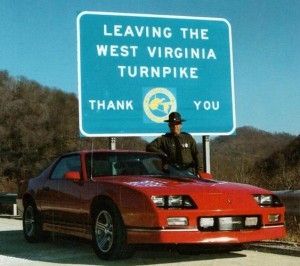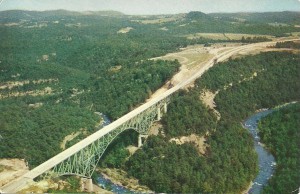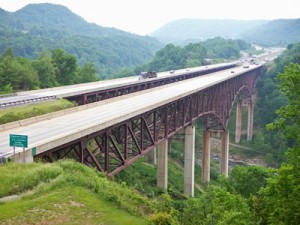The West Virginia Turnpike is only 88 miles long, but it is a critical artery in the state that was previously largely inaccessible. Today it is part of the Interstate Highway System but it traces its history prior to when Interstates began being constructed in 1956.
Let’s take a look at the road some people refer to as “88 miles of miracle”.
Early History
It was in 1949 that the first Turnpike Commission was established to study, and make recommendations for a highway that would better open up the state to commerce. The state’s unforgiving mountains and treacherous roads were limiting growth. Neighboring Pennsylvania and Ohio had turnpikes constructed that were giving them an economic competitive advantage.
After several plans and routes were decided upon and then scrapped, a final route was chosen and in 1952 construction began. Truckload after truckload removed sides of mountain that dynamite had loosened. The initial two lane road was completed two years later at a very high cost as five construction workers lost their lives. While the northern terminus was the large city of Charleston, neither end of the turnpike connected to any other free-flowing roadways. This led a Saturday Evening Post article to refer to it as “The turnpike that goes nowhere”. The road that had conquered the mountains was largely unused. That was until years later and the start of the Interstate Highway System.
A Deadly Reputation
As the four-lane Interstate Highway system began to be built in the late fifties and sixties, it connected to the two-lane West Virginia Turnpike. This increased traffic on the roadway and increased traffic fatalities as well. The road became overcrowded and the tight turns and dangerous conditions led to the road building a reputation as a deadly one. In 1979, 30 people were killed on the roadway. Grim bumper stickers and T-Shirts were sold bearing the words “I survived the West Virginia Turnpike”.

The 1970s Upgrade
After studies were completed in the early 70’s, construction on upgrading the highway began in 1976. It would take the next eleven years to bring the original two lane roadway to 4 lane Interstate Highway standards…with one exception: The Memorial Tunnel. The two-lane tunnel was considered a modern miracle when it was first completed, but now served as a bottleneck. It was decided the tunnel would be bypassed and closed. Today the closed tunnel, and last remnant of the original two-lane turnpike, is used by the National Response Center for training purpose.

The Turnpike Today
Today the turnpike is 4 lanes from Charleston through to the Virginia state line at Princeton. Large bridges, great views and two lengthy tunnels are part of a journey on the roadway, with three toll booths collecting $2.00 each along the way. Third lane “truck lanes” have been added to ascending hills to keep slower truck traffic from impeding traffic on the steep inclines.

The original mission of the turnpike has been realized, with interior West Virginia now accessible to the rest of the country. While defensive driving is still recommended on this, as on every roadway, it is a far safer highway now than it was earlier in its history.

 Live Chat
Live Chat










